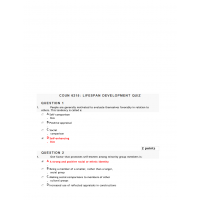COUN 6215 Week 6 Quiz (V1)
COUN 6512 Week 6 Quiz
1. When elementary school children are free to choose whomever they wish to play with, the most consistent finding is that they will choose
2. Counselors working with school-age children and adolescents need to recognize that gender identity continues to develop in these years. Among the important findings from recent research is that girls tend to feel
3. Which of the following parenting styles is most closely associated with positive outcomes in psychosocial development and school achievement for adolescents?
4. To understand parent-teen conflicts, it can be helpful for the counselor to understand the parents’ and teen’s views of parental control. For example, teens often consider some aspects of parental control legitimate but not others. Which of the following kinds of rules governing behavior are
teens most likely to feel that parents should not control?
5. What does contemporary research suggest about the nature of sexual orientation?
6. Which of these is the best summary of developmental trends in the formation of identity?
7. It’s a typical day for Tessa, a counselor who works with teenagers. Marcus explains to her that he came to school high on drugs because he can get away with it. He believes his teachers are clueless when it comes to spotting kids on drugs. Which form of adolescent egocentrism might Elkind use to describe Marcus’ view of the world?
8. Experimentation with deviant or risky behaviors (drug use, vandalism, sex, truancy, etc.) in adolescence is
9. Tiffany is 3 years old. She knows that she is a girl, and she expects to be a girl tomorrow, but she does not understand that her gender is permanent. She believes that cutting her hair short could change her gender. Tiffany has but not .
10. One gender-related characteristic of peer evaluations is that
11. In adolescence and early adulthood, males and females begin to spend more time in mixed-gender groups. Studies of who has more influence on the outcome of problem solving in mixed-gender groups indicate that
12. A coping style which has been linked to higher levels of depression among adolescent
girls and women is
13. Brendt has finished 6th grade in his elementary school, and is beginning 7th grade at a junior high school. According to research on school transitions, what is most likely to be true for Brendt?
14. What is the “two-pronged approach” to helping adolescents with their behavioral, social, or academic problems?
15. Most theories of racial, ethnic or sexual identity include which of the following ideas?
16. Biological females with two X chromosomes are sometimes born with congenital adrenal hyperplasia (CAH), which causes their external genitalia to appear more like those of a male. They may be misidentified at birth and raised as males. If the correct identification is not made before age 3, physicians often advise parents to continue raising the child as a boy, because the child’s gender identity may be difficult to change after age 3. The experiences of CAH girls and other gender atypical children have helped demonstrate that
17. When peers and parents both support academics, adolescents tend to be successful students. When peers and parents are at odds on the importance or value of academics, which of the following is most often true according to research?
18. Roberto, at 15, is finding that he loves to take chances. He enjoys the sensation of being on the edge of danger, whether he is trying a new drug, or riding in a car at top speed with his friends. Roberto was well-behaved, outgoing, and happy as a younger child. If you were his counselor, what would you tell his parents about his current experimentation with deviant behavior?
19. Research indicates that children’s feelings of autonomy from peers are likely to be at their lowest point for which of the following age groups?
20. Steinberg and Scott (2003) argue that when teenagers are found guilty of a crime, it may be that their culpability is mitigated in comparison to that of typical adults. Which of these is not one of the reasons they argue teenagers are probably less culpable than adults?
21. As a toddler, Joey loved to “dance” with his mother and his sisters, twirling around the house to music. By age 5, Joey refused to dance anymore, saying that dancing was for girls. His mother felt that he really wanted to dance but that he just wouldn’t. How would a cognitive theorist explain Joey’s attitude toward dancing?
22. Yvonne is a 13-year-old 8th grader who is a new student in an urban middle school. She recently moved into the area with her mother and her three siblings. The family moved to be nearer to Yvonne’s grandparents after the breakup of her parents’ relationship. Yvonne is tall for her age and is bothered by the looks and sexual comments about her breasts from boys in her school. She has made few friends at the new school. What does this example illustrate about the ease of the adolescent transition for early-maturing girls like
Yvonne?
23. Which of the following is a well-documented gender difference in brain structure?
24. When counseling adolescents who are unsure of their sexual identity, helpers should keep in mind that
25. What kind of peer intervention is least likely to be helpful to troubled teens?
| Institution & Term/Date | |
| Term/Date | Walden University |
-
$9.99











